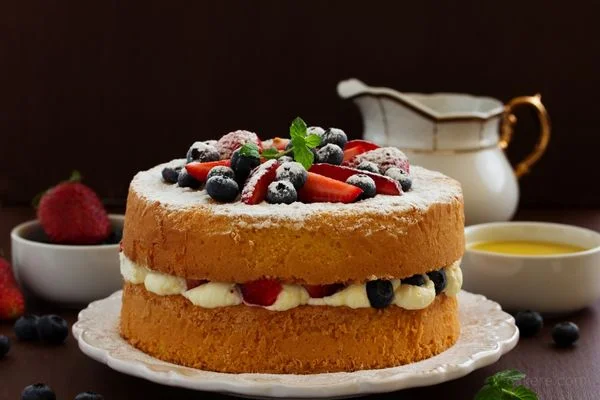If you’re a fan of light, airy cakes with a delicate crumb, you’ve probably come across Genoise Cake. This classic French dessert has been around for centuries and is known for its soft, spongy texture and versatility in pairing with a variety of flavors.
In this article, we’ll explore the history of Genoise Cake, from its origins in France to its popularity around the world. We’ll also delve into the ingredients and techniques used to make this delicious cake, and provide you with some tips for baking it yourself.

So, let’s get started with the delicious journey of the Genoise Cake.
- The Origins of Genoise Cake: A French Delight
- Ingredients and Techniques Used in Making Genoise Cake a. Flour and Eggs: The Foundation of Genoise Cake b. Sugar and Flavorings: Adding Sweetness and Depth c. Mixing and Baking: The Key to a Perfect Genoise Cake
- Variations of Genoise Cake Around the World a. Italian Pan di Spagna: A Lighter Take on Genoise Cake b. British Victoria Sponge Cake: A Popular Tea-time Treat c. Japanese Castella Cake: A Sweet and Simple Delight
- Tips for Baking the Perfect Genoise Cake at Home a. Preparing Your Ingredients and Equipment b. Mixing Your Batter: The Dos and Don’ts c. Baking and Cooling Your Cake: Timing is Key
- FAQs about Genoise Cake a. What Makes Genoise Cake Different from Other Sponge Cakes? b. Can Genoise Cake Be Made Without Butter? c. How Long Does Genoise Cake Last?
- A Delicious Tradition That Has Stood the Test of Time
- The Origins of Genoise Cake: A French Delight a. A Brief History of Genoise Cake b. The Name “Genoise”: A Tribute to the Region of Genoa
- Ingredients and Techniques Used in Making Genoise Cake a. Flour and Eggs: The Foundation of Genoise Cake i. Choosing the Right Flour ii. Separating Your Eggs b. Sugar and Flavorings: Adding Sweetness and Depth i. Using the Right Amount of Sugar ii. Adding Flavorings: Vanilla, Lemon Zest, and More c. Mixing and Baking: The Key to a Perfect Genoise Cake i. Whisking Your Eggs and Sugar ii. Folding in the Flour (H4) iii. Baking Your Cake
- Variations of Genoise Cake Around the World a. Italian Pan di Spagna: A Lighter Take on Genoise Cake i. What Makes Pan di Spagna Different from Genoise Cake? ii. Tips for Baking Pan di Spagna b. British Victoria Sponge Cake: A Popular Tea-time Treat
FAQs
Genoise Cake is known for its light, airy texture and delicate crumb, which is achieved by whisking the eggs and sugar together until they’re pale and frothy, then carefully folding in the flour to create a batter that rises evenly in the oven.
Yes, it’s possible to make Genoise Cake without butter. Some recipes call for using only egg whites or a combination of whole eggs and egg whites, while others use oil or margarine instead of butter.
Genoise Cake can be stored at room temperature for up to 2 days, or in the refrigerator for up to a week. To keep it fresh, wrap it tightly in plastic wrap or aluminum foil.
Conclusion
In conclusion, the history of Genoise Cake is a delicious journey that spans centuries and continents. From its origins in France to its popularity around the world, this classic sponge cake has stood the test of time thanks to its light, airy texture and versatility in pairing with different flavors.
